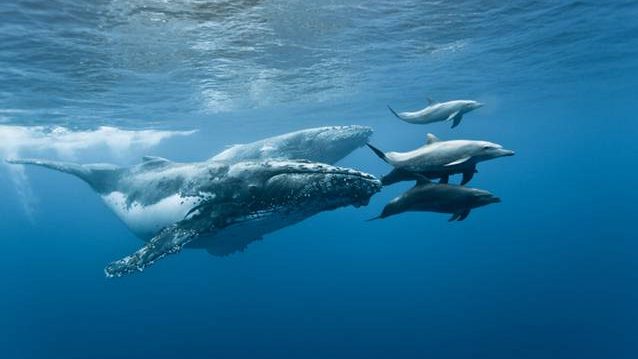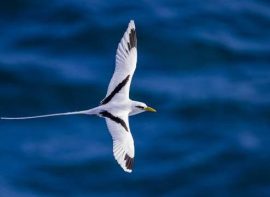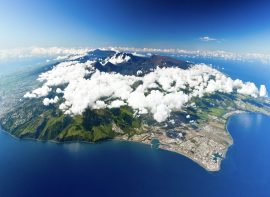

La faune et la flore marine, véritable arc-en-ciel sous-marin
Reunion Island is a geologically relatively young volcanic island (3 million years old) that rests directly on the ocean floor at great depths (-4,000 meters), which explains the scarcity of coral reefs and lagoons, unlike its older sister island, Mauritius. The island is therefore made up of young reefs (around 8,000 years old) that delimit small lagoons (200 meters wide at most) and shallow depths, but which boast a rich fauna. On Reunion Island, the lagoons are located on the west and south-west coasts (Côte-sous-le-vent) from Saint-Gilles to Saint-Pierre.
Réunion’s marine biodiversity is a rare, unique and fragile treasure. It includes more than 150 species of coral, around 3,000 species of mollusks, 500 species of crustaceans, 130 species of echinoderms (starfish, sea urchins, sea cucumbers, etc.), and almost 900 species of fish, some of which are endemic.
Corals
The foundation of the reef, the coral is built tirelessly by the nocturnal spawning of billions of reef polyps, whose larvae settle on a hard substrate (rock, wreck, volcanic flow…) to gradually form the coral. It’s a very slow process, taking around 10 years for a colony of polyps to form a small branch of coral. Coral is the first link in the life of the reef and lagoon, which is why it’s so important to respect and protect it. Because coral is threatened by human activity (ocean warming, urbanization, polluted wastewater, poaching, tourism…).
Numerous initiatives have been taken in recent years to protect this remarkable environment, notably in the form of the marine nature reserve, but much remains to be done to preserve the richness and beauty of Réunion’s lagoons.
The inhabitants of the lagoon
The majority of species live in coral reefs, where numerous ecological niches enable them to establish a territory, feed, hide, hunt… They are dependent on the extremely rich ecosystems of coral reefs and lagoons. Others live further offshore, where space and depth dominate.
Among the reef’s most characteristic fish are the Balloon fish, the Balistes Picasso, the Moorish idols, the Coach fish, the Butterfly fish, the Forktail surgeon, the Angel fish, the Emperor fish, the Labres and the famous Clown fish…
Inhabitants of the open sea
Off the coast of Réunion Island, the Indian Ocean is also home to an exceptional marine fauna, a veritable paradise for divers, with a multitude of marine species more imposing than those usually found in the lagoon. These include sea turtles (the Green Turtle and the Hawksbill Turtle), various species of shark, dolphins, rays, barracudas, tuna, swordfish, bream and marlin. Humpback whales also frequent Reunion waters from June to September.
The turtles
Reunion is a former nesting ground for turtles. These animals have gradually deserted the island due to hunting and urbanization. In recent years, however, major efforts have been made to protect the turtles. The Kélonia center in Saint-Leu, for example, is constantly working to raise public awareness and improve the situation of turtles on Réunion, who have been returning to nest on the island for some years now.
The whales
Every year, from June to September, humpback whales arrive from Antarctica to give birth in Reunion’s waters. They take advantage of climatic conditions that are more favorable to the birth and survival of their calves.
During this period, these gigantic animals can be seen performing magnificent acrobatics from land. At sea, you can witness extraordinary aquatic ballets between whales and calves. In the water, you can also hear whales singing, without even seeing them.
In order to protect cetaceans in their natural environment, and to limit behavioral aberrations, a charter for approaching and observing cetaceans has been set up by the authorities on Reunion Island. Whales are observed and recorded by the GLOBICE association.
Dolphins
Groups of dolphins have taken up residence off the coast of Reunion Island. It’s not unusual to come across one on a boat trip. These groups include several species of dolphin: bottlenose dolphins, spotted dolphins, Fraser dolphins and the bottlenose dolphin, found on the west coast off Saint-Gilles or in Saint-Paul bay.
Sharks
Several dozen species of shark live off the island’s coast. They are rather discreet. What’s more, their numbers are relatively small.
The most dangerous sharks, such as the Tiger shark and the Bulldog shark (species implicated in the majority of attacks on surfers on Reunion Island), are difficult to encounter. They are now subject to preventive fishing under the aegis of the CRA (Centre de Ressources et d’Appui sur le risque requin).
Follow the safety instructions issued by the authorities, especially if you’re out on the water (surfing, paddle boarding, bodyboarding).







